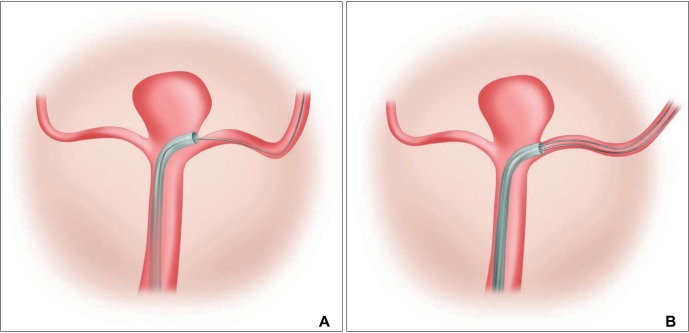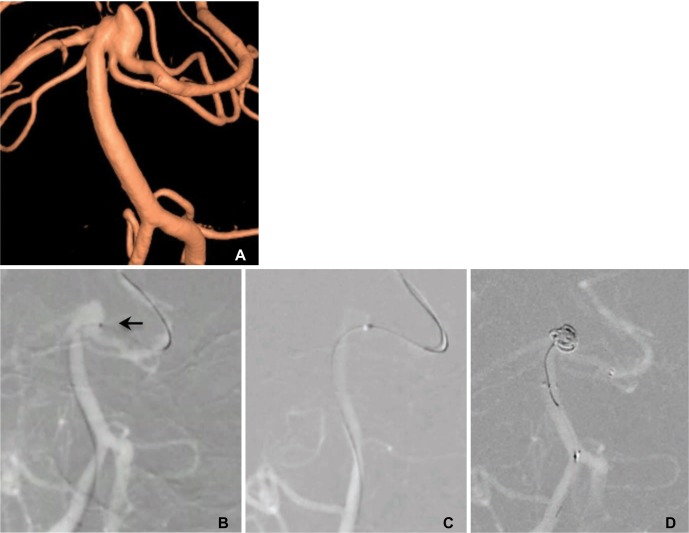Neurointervention.
2016 Mar;11(1):24-29. 10.5469/neuroint.2016.11.1.24.
Easy Advancement of a Large-Profile Microcatheter (Excelsior XT27(TM)) by Parallel Use of Two Microguidewires For Stent Delivery
- Affiliations
-
- 1Department of Radiology, Research Institute of Radiology, Asan Medical Center, University of Ulsan College of Medicine, Seoul, Korea. dhlee@amc.seoul.kr
- 2Department of Neurosurgery, Asan Medical Center, University of Ulsan College of Medicine, Seoul, Korea.
- 3Department of Neurology, Soetomo General Hospital/Airlangga University Hospital, Airlangga University Medical Faculty, Surabaya, Indonesia.
- KMID: 2155715
- DOI: http://doi.org/10.5469/neuroint.2016.11.1.24
Abstract
- PURPOSE
In the endovascular treatment of cerebral aneurysms, navigating a large-bore microcatheter for delivery of an open-cell stent can be challenging, especially in wide-necked bifurcation aneurysms. We were able to overcome this difficulty by parallel use of two microguidewires through the stent-delivery microcatheter.
MATERIALS AND METHODS
From December 2014 to April 2015, we treated 15 patients with wide-necked bifurcation aneurysms. For stent delivery, we used a 300-cm 0.014-in microguidewire (Transend), which was placed into the target branch using an exchange technique. A 0.027-in microcatheter (Excelsior XT-27), which was designed for the stent, was advanced over the exchange microguidewire. If we had trouble in advancing the microcatheter over the exchange microguidewire, we inserted a regular microguidewire (Traxcess), into the microcatheter lumen in a parallel fashion. We also analyzed the mechanism underlying microcatheter positioning failure and the success rate of the 'parallel-wire technique'.
RESULTS
Among the 15 cases, we faced with navigation difficulty in five patients. In those five cases, we could advance the microcatheter successfully by applying the parallel-wire technique. There were no procedure-related complications.
CONCLUSION
Simply by using another microguidewire together with pre-existing microguidewire in a parallel fashion, the stent-delivery microcatheter can be easily navigated into the target location in case of any advancement difficulty.
Keyword
MeSH Terms
Figure
Reference
-
1. Hong Y, Wang YJ, Deng Z, Wu Q, Zhang JM. Stent-assisted coiling versus coiling in treatment of intracranial aneurysm: a systematic review and meta-analysis. PLoS One. 2014; 9:e82311. PMID: 24454690.
Article2. Piotin M, Blanc R, Spelle L, Mounayer C, Piantino R, Schmidt PJ, et al. Stent-assisted coiling of intracranial aneurysms: clinical and angiographic results in 216 consecutive aneurysms. Stroke. 2010; 41:110–115. PMID: 19959540.3. Izar B, Rai A, Raghuram K, Rotruck J, Carpenter J. Comparison of devices used for stent-assisted coiling of intracranial aneurysms. PLoS One. 2011; 6:e24875. PMID: 21966374.
Article4. Chalouhi N, Jabbour P, Singhal S, Drueding R, Starke RM, Dalyai RT, et al. Stent-assisted coiling of intracranial aneurysms: predictors of complications, recanalization, and outcome in 508 cases. Stroke. 2013; 44:1348–1353. PMID: 23512976.
Article5. Kim BM, Kim DJ, Kim DI. Stent application for the treatment of cerebral aneurysms. Neurointervention. 2011; 6:53–70. PMID: 22125751.
Article6. Maldonado IL, Bonafé IL. Stent-Assisted Techniques for Intracranial Aneurysms. InTech. 2012; 14:291–312.7. Gross BA, Frerichs KU. Stent usage in the treatment of intracranial aneurysms: past, presents, and future. J Neurol Neurosurg Psychiatry. 2013; 84:244–253. PMID: 23138770.8. Lin N, Ho A, Gross BA, Pieper S, Frerichs KU, Day AL, et al. Differences in simple morphological variables in ruptured and unruptured middle cerebral artery aneurysms. J Neurosurg. 2012; 117:913–919. PMID: 22957531.
Article9. Tykocki T, Kostkiewicz B. Correlation between the aneurysm morphometry and severity of subarachnoid hemorrhage in the posterior cerebral circulation. World Neurosurg. 2014; 82:1100–1105. PMID: 25009163.
Article10. The 2013 Buyer's guide Endovascular Today. Accessed September 29, 2015. http://bmctoday.net/evtoday/buyersguide/2013/pdfs/Hydrophilic Guidewires.pdf.
- Full Text Links
- Actions
-
Cited
- CITED
-
- Close
- Share
- Similar articles
-
- Open-cell Stent Deployment across the Wide Neck of a Large Middle Cerebral Aneurysm Using the Stent Anchor Technique
- Jailing Technique Using a Catheter-based Open-cell Stent System in Internal Carotid Artery Sidewall Aneurysms Unfeasible to Simple Coiling
- Refinement of a Thrombectomy Technique to Treat Acute Ischemic Stroke: Technical Note on Microcatheter Advance during Retrieving Self-Expandable Stent
- The Interference Phenomenon of Microcatheters in the Jailing Treatment for Internal Carotid Artery Side Wall Aneurysms with an Open Cell Stent System
- Suction thrombectomy of distal medium vessel occlusion using microcatheter during mechanical thrombectomy for acute ischemic stroke: A case series



